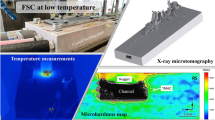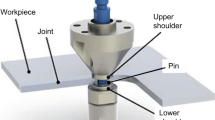Abstract
Submerged bobbin tool (SBT) tunneling is a new friction stir processing (FSP) technique for making integral channels within malleable materials. Like a conventional bobbin tool (BT) for friction stir welding (FSW), an SBT toolset has two opposing shoulders spaced apart along the bobbin or probe section of the tool. Unlike a conventional BT, an SBT is used to form integral subsurface channels by passing the shoulder at the distal end of the probe through the workpiece during processing. Example uses of internal pathways are found in heat exchangers, cooling plates, and vacuum tools. Advance uses may include lessening weight and modifying the stiffness of structural components. A preliminary evaluation in AA6061-T6511 plates shows this special form of FSP has low process forces and is therefore capable of being deployed on CNC (computer numerical control) machining centers and friction stir-capable industrial robots as well as purpose-built FSP machines. Consequently, SBT tunneling holds potential use in a wide range of applications requiring curvilinear internal pathways for wiring, gases, and fluids, as well as internal spaces for the placement of powders and solid materials like composites.
Access this chapter
Tax calculation will be finalised at checkout
Purchases are for personal use only
Similar content being viewed by others
References
Mishra R (2004) Integral channels in metal components and fabrication thereof. US Patent Application Publication 20040060965A1. 1 April 2004
Mishra RS (2005) Integral channels in metal components and fabrication thereof. US Patent 6,923,362. 2 August 2005
Mishra RS (2008) Integral channels in metal components and fabrication thereof. US Patent 7,354,657. 8 April 2008
Ayub ZH (2003) Plate heat exchanger literature survey and new heat transfer and pressure drop correlations for refrigerant evaporators. Heat Transfer Eng 24(5):3–16. https://doi.org/10.1080/01457630304056
Miller WS, Zhuang L, Bottema J, Wittebrood AJ, De Smet P, Haszler A, Vieregge A (2000) Recent development in aluminium alloys for the automotive industry. Mater Sci Eng, A 280(1):37–49. https://doi.org/10.1016/S0921-5093(99)00653-X
Harris C (2001) Design, fabrication, and testing of cross flow micro heat exchangers. Doctor of Philosophy. Louisiana State University and Agricultural & Mechanical College. https://doi.org/10.31390/gradschool_disstheses.290
Launay S, Sartre V, Bonjour J (2007) Parametric analysis of loop heat pipe operation: a literature review. Int J Therm Sci 46(7):621–636. https://doi.org/10.1016/j.ijthermalsci.2006.11.007
Balasubramanian N, Krishnamurthy K, Mishra RS (22 May 2009) Preliminary study of pressure drop and heat transfer through a friction stir channel. ASME 2007 international mechanical engineering congress and exposition. Seattle, Washington, USA pp 933–939. https://doi.org/10.1115/IMECE2007-41634
Balasubramanian N, Mishra RS, Krishnamurthy K (2009) Friction stir channeling: Characterization of the channels. J Mater Process Technol 209(8):3696–3704. https://doi.org/10.1016/j.jmatprotec.2008.08.036
Balasubramanian N, Mishra RS, Krishnamurthy K (2010) Development of a mechanistic model for friction stir channeling. J Manuf Sci Eng 132(5):054504. https://doi.org/10.1115/1.4002453
Balasubramanian N, Mishra RS, Krishnamurthy K (2011) Process forces during friction stir channeling in an aluminum alloy. J Mater Process Technol 211(2):305–311. https://doi.org/10.1016/j.jmatprotec.2010.10.005
Pandya S, Mishra RS, Arora A (2019) Channel formation during friction stir channeling process—a material flow study using X-Ray micro-computed tomography and optical microscopy. J Manuf Process 41:48–55. https://doi.org/10.1016/j.jmapro.2019.03.021
Mehta KP, Vilaça P (2022) A review on friction stir-based channeling. Crit Rev Solid State Mater Sci 47(1):1–45. https://doi.org/10.1080/10408436.2021.1886042
Di Pietro V, Gandra J, Dodds S (3 May 2021) Thermal management of power components and electric systems using channels embedded in metallic parts by friction stir channelling. PCIM Europe digital days 2021; international exhibition and conference for power electronics, intelligent motion, renewable energy and energy management. VDE VERLAG GMBH, Berlin, Offenbach, pp 1138–1143
Di Pietro V, Gandra J, Clarke A, Hockaday J, Law R (March 2022) Removing design and manufacturing complexity from integrated thermal management solutions using friction stir channelling. presented at the 2022 38th semiconductor thermal measurement, modeling and management symposium (SEMI-THERM). San Jose, CA. https://ieeexplore.ieee.org/document/9755866
Karvinen H, Nordal D, da Silva PSV (2018) Microstructural characterization of the stir processed zones of Cu-Al and Al-Al plate systems manufactured by hybrid friction stir channeling. 12th lnternational symposium on friction stir welding. TWI Ltd. Session 7 (Techniques II). 26 June 2018. https://research.aalto.fi/en/publications/microstructural-characterization-of-the-stir-processed-zones-of-c
Karvinen H, Nordal D, Galkin T, Vilaça P (2018) Application of hybrid friction stir channeling technique to improve the cooling efficiency of electronic components. Welding World 62(3):497–509. https://doi.org/10.1007/s40194-018-0576-8
Burford DA, Mishra R (28 July 2022) Systems and methods for internal channel formation within a workpiece. US Patent Application Publication 20220234132A1
Goetze P, Kopyściański M, Hamilton C, Dymek S (12 Feb 2019) Comparison of dissimilar aluminum alloys joined by friction stir welding with conventional and bobbin tools. In: Friction stir welding and processing X, the minerals, metals and materials series. Springer, Cham pp 3–12. https://doi.org/10.1007/978-3-030-05752-7_1
Burford D (15 March 2022) Submerged bobbin tool (SBT) tunneling technology. presented at the AeroMat 2022. Pasadena, CA. https://asm.confex.com/asm/aero22/webprogram/Paper55159.html
Burford D (2022) Submerged bobbin tool (SBT) tunneling technology. presented at the AeroMat 2022: research and development enabling next-generation aerospace materials. Pasadena, CA. https://www.youtube.com/watch_popup?v=49mS2jZyAN4
Koonce JG (2022) Impact of processing parameters and forces on channels created by friction stir bobbin tools, master’s thesis. University of North Texas (UNT). https://digital.library.unt.edu/ark:/67531/metadc1944372/
Acknowledgements
Funding for the initial development phase of the SBT tunneling process was provided through the Advanced Materials & Manufacturing Processes Institute (AMMPI) located at the Discovery Park campus of the University of North Texas (UNT). The technology transfer phase conducted during the summer of 2021 was funded by a grant from AMMPI. Submerged Bobbin Tool (SBT) Tunneling Technology is a patent pending process of UNT.
Author information
Authors and Affiliations
Corresponding author
Editor information
Editors and Affiliations
Rights and permissions
Copyright information
© 2023 The Minerals, Metals & Materials Society
About this paper
Cite this paper
Burford, D.A. et al. (2023). Submerged Bobbin Tool (SBT) Tunneling Technology. In: Hovanski, Y., Sato, Y., Upadhyay, P., Naumov, A.A., Kumar, N. (eds) Friction Stir Welding and Processing XII. TMS 2023. The Minerals, Metals & Materials Series. Springer, Cham. https://doi.org/10.1007/978-3-031-22661-8_23
Download citation
DOI: https://doi.org/10.1007/978-3-031-22661-8_23
Published:
Publisher Name: Springer, Cham
Print ISBN: 978-3-031-22660-1
Online ISBN: 978-3-031-22661-8
eBook Packages: Chemistry and Materials ScienceChemistry and Material Science (R0)




